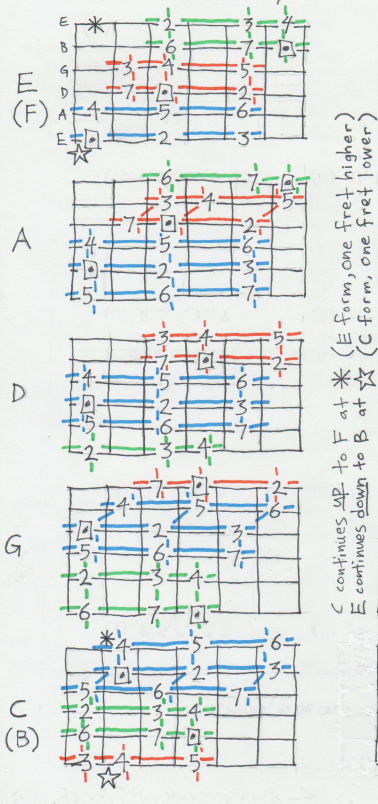I think from your question wording it's clear you understand that major/minor scales and blues scales play are significantly different. But I think there are two things to think about regarding "woodsheding" the fretboard:
- think of three basic finger groupings: lower, middle, upper
- shift patterns across the strings - not up the frets
For the finger groupings the basic idea is the same thing can be played with three different finger groupings (positions.) Here is an example for a major tetrachord (the first four tones of a major scale.)

The G D are string letters and the numbers of the scale degree numbers. Green is what I call "lower" position and the 1 scale degree would be played with finger 4.
Orange is middle position, degree 1 would be played with finger 2.
Blue is upper position, degree 1 would be played with finger 1.
The point is to associate alternate fret choices with the direction your are moving on the fretboard and then practice the right fingers that make things reachable. It makes sense for "three notes per string" which is a common approach for playing diatonic scales & modes. It doesn't apply to two notes per string pentatonic boxes.
Transposing scale across the strings - transposing by perfect fourths - will help learn patterns and especially internalize the funny shift in the "shape" patterns that happens when moving over the G and B strings. Here is the major scale transposing by fourths...

The dot enclosed in a box is the tonic for each scale and the numbers are the other scale degrees. The three colors just highlight three basic box shapes that make up the diatonic scales & modes, and each color represents a lower, middle, and upper position as I described above.
Lower, middle, upper positions aren't all on that charts, here are all three line up so the tonic stays on the same fret starting with string 6...

Notice that with C(B) box the tonic shifts up one fret on the B string. At that point when you transpose up another fourth you will go back to the E(F) box but it will now be shifted up one fret. When you keep transposing in fourths like this you will repeat the five patterns across the strings and shift up one fret after each series of five.
It's important to start and end each box on the tonic to get the proper sound of the major mode and feel the targeting of the tonic in the various lower, middle, upper positions.
While that sequence will take you through the major scale in all keys, it also provides a sort of "hidden" mode exercise. As major scales the tonics ascend E, A, D, G, C... But, we can imagine the starting tonic for E - string 6, first fret - staying fixed and then the five patterns move through the various modes on E. The A major box becomes E mixolydian, D major becomes E dorian, G becomes E aeolian, C(B) becomes E phrygian.
If that stuff about modes is confusing, don't worry about it for now. When you get familiar with playing in all 12 major keys the understanding of modes will come easier.
Basically those three colored boxes repeat across the strings endlessly, and you can shift around your fingering, or change the starting point to get the major scale and all the modes in various positions.
I have seen a number of guides that show "three notes per string" scale where the patterns shift up the frets essentially going through all the modes of one scale. There is a subtle difference between that and transposing by fourths across the strings. When you go up the frets through the modes you get a sense there are many, many different boxes for all the modes and which string gets the tonic. But in reality there is only one diatonic pattern on the fretboard!
It's hard to see the pattern, because of the one fret shift between the G and B strings to go up a perfect fourth. You can visualize it by looking at the orange box in the E and A patterns. In the E pattern it looks like a square next to a rectangle. But in the A pattern it sort of leans over and becomes trapezoidal. That's the "shift!" The box is the same, just tilted. If you practice across the strings, transposing by fourths (you can do it with any musical passage, pentatonic boxes, arpeggios, and so on) you will start to see there is only one diatonic pattern instead of many confusing patterns.



